How to Insert Current Timestamp in PostgreSQL
-
What Is
timestampin PostgreSQL -
Use the
NOW()Function to Insert Current Timestamp in PostgreSQL -
Use the
CURRENT_TIMESTAMPFunction to Insert Current Timestamp in PostgreSQL -
Use the
LOCALTIMESTAMPFunction to Insert Current Timestamp in PostgreSQL

Often, we have to keep the current date and time data in a database. For example, we might want to keep a log of when a customer places an order on our website.
In such situations, when our application or website is dynamic, it is not feasible to manually write and insert the current date and time, which might also result in human errors.
Therefore, this article will discuss the different ways to insert the current timestamp in a table in PostgreSQL and their usage and limitations. Before we jump straight to them, let us first understand the meaning of timestamp.
What Is timestamp in PostgreSQL
In PostgreSQL, timestamp is a data type that stores the date and time without a time zone. A datatype for any programming language is a specific entity distinguished by the type of values it stores.
A timestamp datatype variable is declared in the following way in PostgreSQL.
variable_name timestamp
Now that you know what a timestamp in PostgreSQL is let us move on to understanding different functions that help us retrieve the current date and time and insert it into a timestamp variable.
For understanding purposes, we are creating the following table.
create table example1
(
variable_name timestamp
);
If we want to manually insert some time and date into this table, we can do it in the following way.
INSERT INTO example1
VALUES ('2022-08-23 18:42:02');
We can see that this data has been inserted successfully.

However, as we discussed earlier, manually inserting time and date data is not a good practice. Therefore, PostgreSQL provides us with different functions which we can use to insert the current time and date in a timestamp variable.
Let us understand their usage one by one.
Use the NOW() Function to Insert Current Timestamp in PostgreSQL
The NOW() function in PostgreSQL returns the current date and time with the time zone. The time zone data used is according to the settings of the database server in use.
The NOW() function is used in the following way.
SELECT NOW();
We can see that the output is returning the timestamp value with the time zone as follows:

If we want to convert it to a value without a time zone, we can use it in the following way.
SELECT NOW()::timestamp;
This gives us the following output.

We can use the NOW() function to insert the current timestamp in a table. Let us demonstrate it by inserting some values in the example1 table.
INSERT INTO example1 VALUES (now());
The value will be successfully inserted, as shown below.
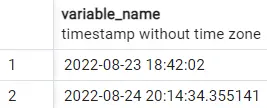
Note: The time and date value retrieved from
NOW()will be automatically cast towithout time zonewhen it is inserted in atimestampvariable, as shown in the output.
Use the CURRENT_TIMESTAMP Function to Insert Current Timestamp in PostgreSQL
The CURRENT_TIMESTAMP function is similar to the NOW() function, as it also returns the current date and time data with the time zone.
These two functions can be used interchangeably as alternatives to each other. The CURRENT_TIMESTAMP function displays results in the following way.
SELECT CURRENT_TIMESTAMP;

Similar to the NOW() function, we can convert this data to a timestamp without a time zone in the following way.
SELECT CURRENT_TIMESTAMP::timestamp;
We can see in the result that the time zone has been removed from the time data.

We can use the CURRENT_TIMESTAMP function to insert the current timestamp in a table. Let us demonstrate it by inserting some values in the example1 table.
INSERT INTO example1 VALUES (CURRENT_TIMESTAMP);
The value will be successfully inserted, as shown below.
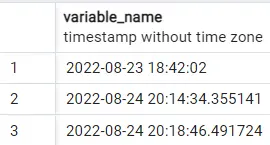
Another aspect of using the CURRENT_TIMESTAMP function is that we can adjust the precision of the time returned. For example, we can see in the above output that the time is shown accurately to 6 decimal places.
However, PostgreSQL allows us to adjust this precision according to our needs. The syntax is demonstrated in the following query.
SELECT CURRENT_TIMESTAMP(2);

We can see in the output that the time is accurate to 2 decimal places, as requested in the precision parameter. The current timestamp can be inserted after defining a precision, as shown below.
INSERT INTO example1 VALUES (CURRENT_TIMESTAMP(2));
The successful insertion is shown below.
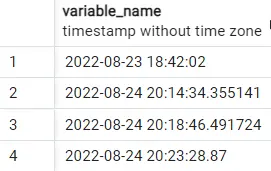
Use the LOCALTIMESTAMP Function to Insert Current Timestamp in PostgreSQL
Lastly, we have the LOCALTIMESTAMP function, which serves the same purpose of retrieving the current date and time. However, unlike the NOW() and CURRENT_TIMESTAMP functions, the LOCALTIMESTAMP function returns time and date without a time zone.
Let us see how it is used to retrieve current timestamp data.
SELECT LOCALTIMESTAMP;
This gives the following output.

Therefore, we can use the LOCALTIMESTAMP function to insert the current timestamp in a table. Let us demonstrate it by inserting some values in the example1 table.
INSERT INTO example1 VALUES (LOCALTIMESTAMP);
The value will be successfully inserted, as shown below.
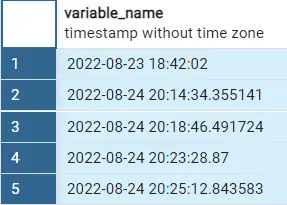
Similar to the CURRENT_TIMESTAMP function, we can specify the time precision in the LOCALTIMESTAMP function. The syntax for this is as follows:
SELECT LOCALTIMESTAMP(2);

We can see in the output that the time is accurate to 2 decimal places, as requested in the precision parameter. The current timestamp can be inserted using the LOCALTIMESTAMP function by specifying the precision, as shown below.
INSERT INTO example1 VALUES (LOCALTIMESTAMP(2));
The successful insertion is shown below.
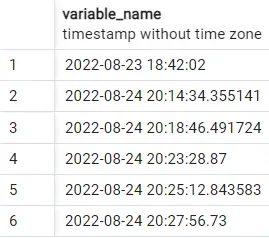
This sums up all the different ways to insert the current timestamp in a table in PostgreSQL. We hope you have learned how to use the NOW(), CURRENT_TIMESTAMP and LOCALTIMESTAMP functions to insert the date and time values in a timestamp datatype variable.
Hello, I am Bilal, a research enthusiast who tends to break and make code from scratch. I dwell deep into the latest issues faced by the developer community and provide answers and different solutions. Apart from that, I am just another normal developer with a laptop, a mug of coffee, some biscuits and a thick spectacle!
GitHub